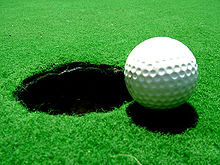Golf ball
A golf ball is a game device in golf .
Properties and structure
The size and texture of a golf ball are defined in the golf rules. The diameter of a golf ball is at least 42.672 mm (1.68 ″), the maximum weight is 45.926 g (1.62 oz.). The surface of the ball has 300 to 450 small dents (so-called dimples), although the exact number of "dimples" is not specified. Almost every manufacturer has a different arrangement of the dimples, which are supposed to improve flight characteristics. The first golf balls did not have dimples, but were simply round and smooth. It was found, however, that the golf balls, which had notches and furrows from years of use, flew further and better. So it was started to carve furrows in the smooth golf balls.
A golf ball consists of a hard plastic shell ( gutta-percha was used in the past ) with different cores. In addition to hard rubber cores, multi-layer cores made of various flexible materials are also increasingly being used. Depending on the number of different layers, one speaks of 2-piece, 3-piece, 4-piece (and so on) balls. Most golf balls have a number printed on them. This is used to distinguish the ball from balls of other players (or another ball of their own) if they use a ball of the same brand and type.
The golf ball in play
It has become common practice in tournaments to announce the brand, type and number of the ball before the first tee. As soon as the ball can be changed in accordance with the rules, this information should also be passed on to the other players. This procedure is a question of etiquette and not a rule. This practice becomes important when a ball lands in the rough and needs to be searched for and correctly identified. A corresponding announcement is also common when a player hits a provisional ball after a failed stroke.
physics
The trajectory of a golf ball is determined by weight and aerodynamic forces.
Due to the angle of the club head ( loft ), the ball is set into rotation when hit, which contributes to the necessary directional stability during flight. Each golf stroke triggers a backward spin, provided that the ball is hit with the clubface. The different trajectories are triggered by additional lateral rotations.
The dimples on the ball surface reduce the drag coefficient (c w ) by lowering the pressure resistance and reduce the air resistance by up to 50%. Depending on the player's stroke technique, a golf ball can fly up to four times further.
The diameter and the speed of a golf ball are so small that the small Reynolds number suggests a laminar boundary layer flow. Small eddies within the dimples change the laminar boundary layer around the ball into a turbulent boundary layer. The flow separates with a delay and thus reduces the volume of the dead water zone . There is a negative pressure in this area. The smaller the zone, the lower the pressure difference on the upstream side and thus the braking in the direction of flight. The way turbulators work on the wings of small aircraft is based on the same principle . The graphic shows the influence of air friction on the flight distance. With a tee shot speed of 80 m / s (very good player) a golf ball would fly more than 600 m without air friction (c w = 0). Without dimples, the c w value is approx. 0.4, which corresponds to a striking distance of 150 m. With dimples (c w = 0.1) it more than doubles.
There are hundreds of different dimple patterns that are developed by the respective manufacturers of the golf balls.
Golf balls are elastic. With the so-called smash, they store energy when they come into contact with the club, which they release again when they hit the tee. The smash helps increase the speed of the ball. Good golfers reach ball speeds of 250 km / h (70 m / s), the record is 328 km / h (91 m / s).
See also
Web links
Individual evidence
- ↑ zeit.de: That's right / Golf: Do the dents in the golf ball improve its flight characteristics? .
- ↑ Golf ball guide, basic knowledge about golf balls ( memento of the original from September 25, 2015 in the Internet Archive ) Info: The archive link was inserted automatically and has not yet been checked. Please check the original and archive link according to the instructions and then remove this notice. , accessed September 24, 2015.
- ^ German Golf Association, rules accessed on March 23, 2015.
- ↑ aerodynamics of ball flight and 2.1) attempts at lift .
- ↑ The Dimples of the Golf Ball. (Under: Physics in Golf> The Golf Ball). In: golfbaelle.de version 3.0.3. Ingo Martin, accessed February 2, 2018 .



